‘Kumbh’ means an earthen pot. The human body is called ‘Parthiv’ (Predominant in the Absolute Earth Principle). The body is created from earth and merges into the earth; therefore, ‘Kumbh’ (the earthen pot) symbolises the human body.
Following are the benefits derived during the Kumbh Mela :
1. Kumbh Mela, time to empty the body-form
‘Kumbh’ filled with vices lust, sexual desire, anger
Saint Namdev had ego about His thoughts that ‘God likes me, God speaks with me, God dances with me’. Therefore, in a meeting of Saints, Saint Muktabai said, “The pot (Kumbh) of Namdev is full of ego. Hence, Namdev is still immature”. Our pots (Kumbh) too are immature because we have some or the other ego about our appearance, wealth, achievements etc. Therefore, the Kumbh Mela is the best place and time to empty our body-form ‘Kumbh’ filled with such vices.
2. Kumbh Mela bestows benefits
a thousand times more in our spiritual practice
All religious rituals and spiritual practices such as chanting performed at the place and time of the Kumbh Mela bestow benefits a thousand times more when compared with other places and times. Since many Deities, individuals with Divine Knowledge, Saints and Sages congregate during the Kumbh Mela, the benefit of their guidance can be obtained within a short time and at one place.
No special benefits will be obtained just by bathing during the Kumbh Mela. Only if we empty our ‘Kumbh’ our life will be emancipated due to the blessings of the Deities and Sages.’
3. Merit-bestowing
A. As the Kumbh Mela is merit-bestowing, when a Holy bath is taken at Prayag, Haridwar, Ujjain and Tryambakeshwar-Nashik, one gets infinite merits. Hence, millions of devotees, Ascetics and Saints throng to these places.
B. ‘During the Kumbh Mela, many Deities, Mātrukās (Female Deities), Yakshas (Nature-spirits), Gandharva and Kinnars are active in the earth’s orbit. When we perform spiritual practice, we get their blessings, and our tasks reach fruition in a short time.
C. The Kumbh Mela is held on the banks of rivers Ganga, Yamuna, Saraswati, Godavari and Kshipra. Many Deities, Divine souls, Sages and Seers, inferior assistants of Deities residing at these places are also activated during this period and we get their blessings too.
D. The benefits of auspicious karmas performed during this period are infinitely more than at other times. During this period, the action supplements the karma and the karma gets the consent of action.
E. The movement of auspicious waves of Āpatattva (Absolute Water Principle) is in abundance everywhere during the Kumbh Mela. As a result, man’s mind gets purified and the actions that are a result of thoughts in the mind also become fruitful. In other words, actions as well as karmas are purified.
4. Nullifies sins
Many devotees have a Holy bath in the sacred rivers at this Holy place during the Kumbh Mela with the intention of nullifying their sins.
A. Bathing in Ganga
Ganga resides at Prayag (Ganga), Haridwar (Ganga), Ujjain (Kshipra) and Tryambakeshwar-Nashik (Godavari) secretly. Since bathing in River Ganga bestows special religious benefits, devotees and Saints bathe during the Kumbh Mela.
By bathing during the Kumbh Mela, merits equivalent to performing 1,000 Ashvamedha Yadnyas, 100 Vajapeya Yadnyas and 1 lakh pradakshinas (Circumambulations) around the earth are obtained. Similarly, by bathing once during the Kumbh Mela, merits equivalent to 1,000 baths in the Kārtik month, 100 baths in the Māgha month and 1 crore baths in the River Narmada during the Vaishākha month are obtained.
B. Reason for the evolved individuals
bathing in Ganga during the Kumbh Mela
Spiritually evolved individuals bathe in Ganga during the Kumbh Mela; because, Ganga which had become impure due to the bathing of other individuals, gets purified due to the Shakti of the spiritually evolved individuals.
C. Relation between the Kumbh Mela places and River Ganga
The Kumbh Melas at Prayag and Haridwar are held on the banks of the River Ganga.
The Kumbh Mela at Tryambakeshwar-Nashik is held on the banks of River Godavari. Sage Gautam brought Ganga to the Holy place of Tryambakeshwar-Nashik under the name of ‘Godavari’. The Brahmapurana says that ‘The River Ganga beyond the Vindhya Mountain is called Gautami (Godavari).’
The Kumbh Mela at Ujjain is held on the banks of Kshipra River. The Ganga River had met this sacred north-bound river in the ancient times, where Kshipra turns east-bound. Today, a Shivalinga called Ganeshwar is situated at this place. Also in Skandapuran, River Kshipra is considered to be Ganga.
Thus, the history of the Kumbh Holy places is associated with the River Ganga.
5. Pitrutarpana
The main objective of Ganga is to bestow liberation to the departed ancestors. Hence, Dharma recommends performance of pitrutarpana in addition to bathing in Ganga during the Kumbh Mela. ‘Vayu-purana’ says that the Kumbh Mela is useful for performing shrāddha karmas.
6. Company of Saints (Satsang with Saints)
Those who congregate in the Kumbh Mela include the Shankaracharyas of different Peeṭhas (Seats of faith) in Bharat, the Ascetics of 13 Akhadas, Mahamandaleshwars, followers of the Shaiva & Vaishnav sects, many scholars, renunciants, Saints and evolved souls. Hence, the nature of the Kumbh Mela is magnificent as if it is a convention of Saints. Due to the Kumbh Mela, devotees get a golden opportunity to be in the company of Saints.
Reference : Sanatan Sanstha’s Holy Text, ‘Glory of the Kumbha Parva’

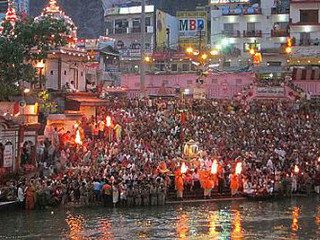

 Holy river
Holy river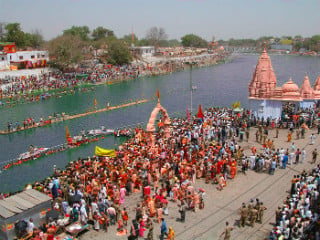 Bathing ghats located along Shipra River
Bathing ghats located along Shipra River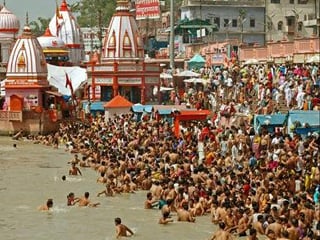 Main Bathing Dates for Kumbha Parva at Haridwar 2021
Main Bathing Dates for Kumbha Parva at Haridwar 2021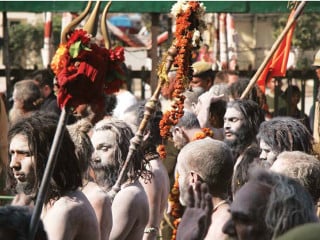 What is Akhada - List of Akhadas
What is Akhada - List of Akhadas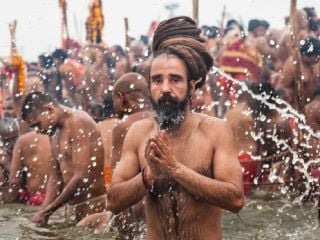 Shahi snan meaning and importance
Shahi snan meaning and importance